
From reel-to-reel tape recorders to cassette tape recorders
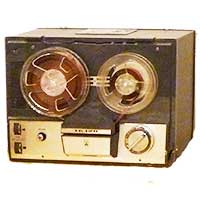
Tape recorders were the only way for the general public to record music and speech in the mid-20th Century. There were two types. The earliest was generally known as the reel-to-reel tape recorder and the later one the cassette recorder, although the terms recorder/player were also used. Both worked with magnetic tape. This page looks at them from the viewpoint of the early DIY enthusiast and the user.
____
By the webmaster, based observations over the years and additional research
Reel-to-reel tape recorders: how they got their name
In the early days of reel-to-reel tape recorders, they were simply called tape-recorders. Only later when the cassette tape recorder came on the market, did they acquire the 'reel-to-reel' name, so distinguishing the two types.
Early reel-to-reel tape recorders
My first introduction to tape recorders was in the 1950s, via my husband who had the reel-to-reel type. He had built the entire system himself from parts available in specialist electronics shops which grew out of the war surplus shops.
The system consisted of the basic tape recorder, a separate amplifier, speakers, microphone and controls. It all looked somewhat messy with visible leads, but as he was well into working with wood, he constructed a smart piece of furniture to house it all. This stood on legs with two lids, one for the recorder itself and the other for the parts. It all looked quite impressive and produced excellent music. However, it took up a lot of space and needed an available electricity supply. It rather dominated the room and was most certainly not portable.
I understand that there were other enthusiasts who had made their own systems.
Reel-to-reel tape recorders appear on the market
Reel-to-reel tape recorders started coming on the market in the late 1950s and early 1960s. They were well-received because they were so novel and they were neatly packaged unlike the DIY versions, although the still needed separate speakers and microphone alongside. They were still heavy, bulky and took up a lot of space.
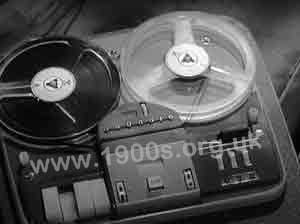
An early shop-bought reel-to-reel tape recorder/player: bulky and unwieldy
Soon smaller versions came available, some with lids and handles on their boxes which made them portable. However, they were still heavy and they still needed an external electricity supply, speakers and microphones. Consequently they were only really used by professionals and enthusiasts.
Reel-to-reel tapes
The tapes were magnetic. Blank ones were available for purchase, but I am reasonably certain that there were no music tapes on sale anywhere.
How a reel-to-reel tape recorder was used
There were buttons for record, play, fast-forward, rewind and stop. Recording off the radio required a lead to connect the radio and the recorder, but for recording a person or live music a separate microphone was needed.
To record, a fully wound reel of tape was placed on the left and an empty one the right. The tape was then threaded over the record/play head and onto the empty reel. Then the record button was pressed.
Playing was the same procedure except that the play button was pressed instead of the record button.
Cassette tape recorders/players
Tape recorders only really hit the mass market with cassette tape recorders, sometimes called compact cassette recorders. A cassette is a flat case or cartridge that can be easily loaded or unloaded.
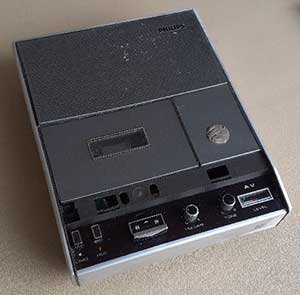
An early cassette recorder/player
In 1962 Philips announced the development of the first compact cassette recorder. It used transistors rather than the old-style valves, so was light-weight and more robust than the older reel-to-reel versions. It was battery-powered with an internal microphone and speaker, so was fully portable for use. We bought ours quite early on, from one of the shops that grew out of the war surplus stores.
We marvelled that we could now walk around and record whatever and wherever we liked without trailing leads. It is difficult to describe the exhilaration of not being tied to one place, and the freedom of just pressing the a to record or play, normal as it is today.
It must be said, though, that the quality of recording and playback was improved with external microphones and speakers, but there were facilities for plugging these in if required.
Cassette tapes
Blank cassette tapes were widely available for purchase and pre-recorded music ones quickly appeared on the market with the music and stories previously available for records on gramophones and record players. These cassette tapes had the advantage of coming in their own protective boxes, but were subject to the same problems of easily breaking and twisting. If mishandled, the tape could become loose or slip of the cassette. We often needed to rewind a tape, carefully using a pencil or ball point pen as a winder.
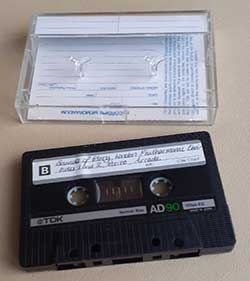
Early compact cassette tape and its box.
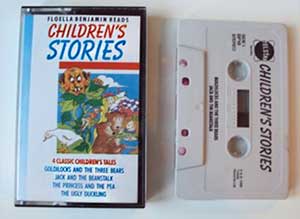
Purchased, pre-recorded stories on cassette tape.
Pre-recorded music tapes were also popular.
All too often, broken tapes were carelessly thrown away so that they caught on hedges and trees and looked like streamers in the wind.
These cassette tapes could be used to record programs or other data from a computer. Where today a simple press of a button saves masses of data in a flash, it could take an hour to save from computer to cassette tape. Similarly to load back from tape to the computer would take an equal amount of time.
Our family at one stage was involved in writing a number of books. This was done on a computer using cassette tapes for backup. By today's standards they took ages to record, and we had fingers crossed throughout the recording and backing up process in case our work would be lost through broken tapes. Nevertheless, we managed to write our first book writing and saving backups on these tapes.
Blank tape cassettes had a tiny piece of plastic that users could remove to prevent the tape being recorded over. Commercially produced tapes of music and stories had this plastic removed before sale.
If you can add anything to this page or provide a photo, I would be pleased if you would contact me.
sources: early 20th century material
sources: ww2 home front and other material
contact
the webmaster/author/researcher/editor
privacy policy
















